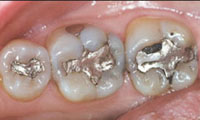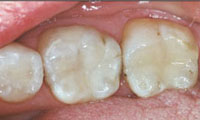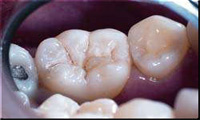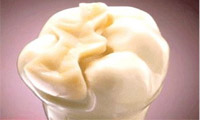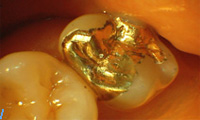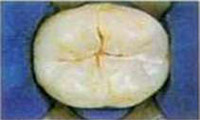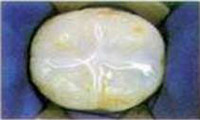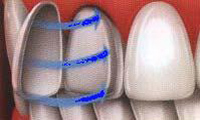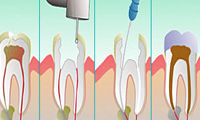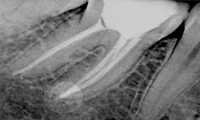Fillings
This is the most commonly used method in our practice. First the dentist removes the decayed tooth surfaces/parts, cleans the affected area and then fills the cleaned cavity/hole with filling material to prevent further tooth decay.
The procedure is normally performed once.
With the development of medicine, amalgam fillings – not very healthy for the organisation and less aesthetic as well – have been replaced by light-curing aesthetic fillings.
Tooth Coloured Fillings (white fillings, composite fillings)
These fillings are usually made of glass particles, synthetic resin and bonding material.
Please contact our dentists to enquire about the material composition.
The above mentioned fillings/materials are the same colour as your teeth, in order to get a natural effect and appearance. In the case of a big hole, the composite filling is not the best solution, because it may break off or wear out. Coffee, tea and tobacco can discolour it. Also, it does not last as long as the other fillings. These fillings typically last for anywhere between 3 to 10 years.
Is it worth replacing the amalgam fillings?
Yes, due to two reasons: allergy and aesthetics.
If you decide to replace these fillings, they can be replaced with tooth coloured fillings.
INLAY
The inlay treatment is also a solution among the teeth prevention treatments. The basic difference between this treatment and the dental filling treatment is that this procedure is performed by the dentist’s and the dental technician’s aligned work. After removing the patient’s decayed tooth parts the dentist creates a special cavern on the tooth, then with the help of an imprint, the dental technician prepares the correct size and coloured inlay in the dental technician laboratory. The procedure requires two occasions and the preparation takes place under local anaesthesia. However, this procedure is more expensive.
The following guidelines help to determine which is best for you:
- the size and extent of tooth decay
- metal allergy
- the place of filling
- costs
What kind of material are inlays made of?
Gold: these inlays are made in laboratories and are glued into place. One of its advantages is that it reduces secondary caries developing under the inlay; in addition it provides a close fit with healthy margins and is entirely allergy-free. Only precious metals are added to the pure gold as alloying materials such as palladium and platina.
Its disadvantages are that it is costly and its gold colour can is very noticeable. The solution to this problem is to combine the gold with porcelain, making it last for more than 20 years. The procedure requires several appointments with the dentist.
Gold base with porcelain: this is the called Galvan technology. The difference between this and the aforementioned method is that the inlay with a gold base is covered with a porcelain veneer. A gold margin is left by the dental technician only at the sides of the inlay for a tighter fit. The advantages are the same as in the case mentioned above. The only disadvantage is that it is possible for the porcelain to chip.
Ceramic: these inlays are made in laboratories and then they are bonded. The original tooth colour can be chosen. This material doesn’t discolour, it is colour-restoring. With ceramic, the main part of the tooth can be recovered. Its price is more favourable as it does not contain the price of gold per gram.
Zirconium-oxide base + porcelain: metal-free inlay, recommended for patients with any kind of metal allergy. It is wear-resistant and can be made of very fine colours. Because of its excellent qualities it is a bit costly but it is worth it.
SEALING OF PITS AND FISSURES
This is one of the most effective methods of preventing tooth decay. It does not require local anaesthesia.
Bacterial plaque easily accumulates and adheres to the top surfaces of the teeth and more specifically in the pits and fissures on the chewing surface of molars. These surfaces are sometimes so deep that brushing cannot reach into the small pits to completely clean them out. Fluid filling materials (sealants) are applied on these unnoticeable fissures. This procedure is called sealing of pits and fissures. This makes the teeth easier to clean and also prevents tooth decay.
VENEER (ceramic shell)
A veneer means a very thin ceramic shell, a layer, which is made by the dental technician. With this restoration-like procedure, chipped, broken, stained and discoloured front teeth can be fixed and made aesthetic. The original tooth is kept; it only goes through an optical change, making it more practical.
This treatment is recommended for patients suffering from metal allergies. Two appointments are necessary. At the first appointment the dentist prepares the tooth, makes an imprint and prepares a temporary replacement. During the second visit the custom veneers (shells) are bonded to the tooth.
Endodontia (Root canal treatment)
The purpose of this treatment is to clean out and treat the root canals of the infected, inflamed, or dead tooth and to remove the dead pulp. Then we hermetically seal the remaining hole with the help of a root-filling material.
Root canal treatment is necessary when the pulp is infected or inflamed. The infection may spread to the surrounding tissues causing suppuration or abscess.
Without endodontia the tooth may have to be extracted. The procedure is painless; it is performed under local anaesthesia. Unfortunately the process is time consuming; you will need to visit your dentist a couple of times.


